U.S. Department of Transportation
Federal Highway Administration
1200 New Jersey Avenue, SE
Washington, DC 20590
202-366-4000
Pavement markings provide directional guidance and sometimes inconspicuous warnings as drivers approach intersections and horizontal curves. Over time, these markings may fade, or increases in traffic volume may warrant pavement markings where none existed previously. This section covers safety improvement treatments that can be applied in the form of pavement marking procedures. Some treatments in this section also appear in the sections on intersection improvements, horizontal curve improvements, and roadside safety.
| Safety Treatment | For more information, visit page | Cost | Frequency of Maintenance (years) | Safety Benefit | Benefit Cost Ratio32 | |||||
|---|---|---|---|---|---|---|---|---|---|---|
| Initial Implementation | Ongoing Maintenance | NCHRP 500 Performance Rating | Crash Modification Factor (CMF) | Lower Volume*, Optimal Conditions*** | Higher Volume**, Optimal Conditions*** | Lower Volume*, Narrower Conditions**** | Higher Volume**, Narrower Conditions**** | |||
| Provide a Stop Bar on Minor Road Approaches | 101 | $ | $ | 5 | P | 337.7 | 1175.8 | 287.1 | 1484.1 | |
| Install Stop Ahead Pavement Markings | 102 | $ | E | 0.44-0.69 | ||||||
| Relocate an Existing Stop Bar on Minor Approach | 103 | $ | T | |||||||
| Use of Optical Speed Bars | 104 | $-$$ | ||||||||
| Install Raised Pavement Markers | 105 | $-$$ | T | ≤0.76 | ||||||
| Install Edge Line Markings | 106 | $$ | - | 5 | P | 0.56-0.62 | 27.9 | 222.8 | 34.1 | 336.1 |
| Install Center Line Markings | 107 | $$ | - | 5 | P | 0.67 | 35.1 | 281.0 | 43 | 424.0 |
| Install Wider Pavement Markings (With or Without Rumble Strips) | 108 | $$ | E | 0.65-0.96 | ||||||
| Implement Lane Narrowing Through Rumble Strips and Painted Median at Rural Stop-controlled Approaches | 109 | $$-$$$ | T | 0.60-0.80 | ||||||
| Install Center Line and Edge Line Markings | 110 | $$$ | - | 5 | P | 16.5 | 132.1 | 20.2 | 199.3 | |
| Convert a Four-Lane Two-Way Road into a Three-Lane Road With One Lane in Each Direction of Travel Plus a Continuous Two-Way Left Turn Lane (Road Diet) |
111 | $$$-$$$$ | P | 0.71-0.95 | ||||||
Convert a Four-Lane Two-Way Road into a Five-Lane Road with Two Lanes in Each Direction of Travel Plus a Continuous Two-Way Left Turn Lane OR Convert a Two-Lane Two-Way Road into a Three-Lane Road Plus a Continuous Two-Way Left Turn Lane |
112 | $$$-$$$$ | T | |||||||
Cost: NCHRP 500 Performance rating33 *Lower Volume ≤ 1000 vpd |
||||||||||
Providing visible stop bars on minor road approaches to unsignalized intersections can help direct the attention of drivers to the presence of the intersection.
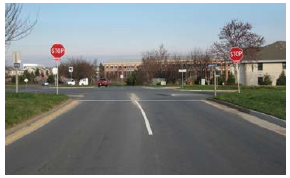
Where to Use: Apply on minor road approaches where conditions allow the stop bar to be seen by an approaching driver at a significant distance from the intersection. Locations should be identified by patterns of crashes related to lack of driver recognition of the intersection.
| Provide a Stop Bar on Minor-Road Approaches - Initial Investment: $1,000 (4ST), $500 (3ST) - Cost of Maintenance: $0 - Frequency of Maintenance: 5 years (4 applications) |
Benefit-Cost Ratio | NCHRP 500 Performance Rating |
|---|---|---|
| Lower Volume 4-Way Intersections | 337.7 | Proven |
| Higher Volume 4-Way Intersections | 1175.8 | Proven |
| Lower Volume 3-Way Intersections | 287.1 | Proven |
| Higher Volume 3-Way Intersections | 1484.1 | Proven |
Top Recommended Resource:
1. FHWA, Intersection Safety: A Manual for Local Rural Road Owners, January 2011. Available at: http://safety.fhwa.dot.gov/local_rural/training/fhwasa1108/fhwasa1108.pdf.
Providing pavement markings with supplementary messages (such as Stop Ahead) can help alert drivers on the stop-controlled approach to the presence of an intersection.
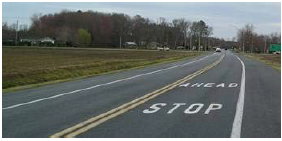
Where to Use: It is likely that Stop Ahead pavement markings will be most effective at locations with a high frequency of target collisions (i.e., right-angle and rear-end), particularly where driver awareness may be an issue.
| Safety Treatment | Initial Implementation Cost | NCHRP 500 Performance Rating | Crash Modification Factor (CMF) |
|---|---|---|---|
| Install Stop Ahead Pavement Markings | $0 to $5,000 | Proven | 0.44-0.69 |
Top Recommended Resource:
1. FHWA, Techbrief: Safety Evaluation of STOP AHEAD Pavement Markings, March 2008. Available at: https://www.fhwa.dot.gov/publications/research/safety/08045/.
A minor approach may have an existing stop bar that is located where vehicles stopping at the bar have limited sight distance at the intersection. The stop bar may be relocated closer to the intersection at a point where the stopped vehicle would have better sight distance for approaching traffic.
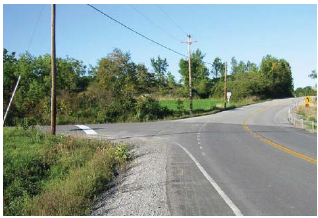
Where to Use: This treatment may be used at locations where existing sight distance may be obstructed or where sight distance may be significantly improved by moving the stop bar.
| Safety Treatment | Initial Implementation Cost | NCHRP 500 Performance Rating |
|---|---|---|
| Relocate an Existing Stop Bar on Minor Approach | $0 to $5,000 | Tried |
Top Recommended Resource:
1. FHWA. NCHRP Report 500 / Volume 5: A Guide for Addressing Unsignalized Intersection Collisions, "Strategy E4. Provide a Stop Bar (or Provide a Wider Stop Bar) on Minor Road Approaches," July 2003. Available at: http://safety.fhwa.dot.gov/intersection/resources/intsafestratbro/ue4.cfm.
Optical speed bars are transverse stripes spaced at gradually decreasing distances. The rationale for using them is to increase drivers' perception of speed and cause them to reduce speed, which can be helpful near intersections or horizontal curves. The Optical speed bar name comes from this intended visual effect on drivers' speed as they react to the spacing of the painted lines. These white transverse stripes are 18 inches long and 12 inches wide. The preferred material is thermoplastic because of the exposure to traffic volume over time.
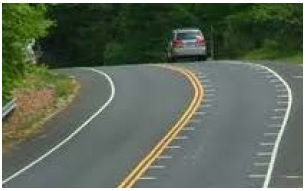
Where to Use: This treatment may be used at locations where speed reductions are needed, such as near intersections and horizontal curves.
| Safety Treatment | Initial Implementation Cost |
|---|---|
| Use of Optical Speed Bars | $0 to $5,000 |
Top Recommended Resource:
1. FHWA, Low Cost Treatments for Horizontal Curve Safety, December 2006. Available at: http://safety.fhwa.dot.gov/roadway_dept/horicurves/fhwasa07002/.
Raised pavement markers are designed to supplement the delineation provided by pavement markings. During certain conditions, particularly on wet roads in the dark, motorists may have difficulty determining the location of the center line and edge line pavement markings, increasing the likelihood of roadway departure. By installing raised pavement markers, the pavement markings are much more prominent in adverse weather conditions, providing important information to the driver.
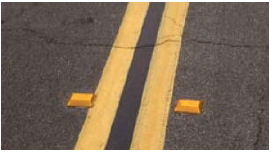
Where to Use: Raised pavement markers should be installed on routes with sufficient pavement quality to hold the devices in place. The type of raised pavement marker to install is dependent on regional climate. For example, in areas that experience snowfall, snow plowable RPMs should be used.
| Safety Treatment | Initial Implementation Cost | NCHRP 500 Performance Rating | Crash Modification Factor (CMF) |
|---|---|---|---|
| Install Raised Pavement Markers | $0 to $20,000 | Tried | ≤ 0.76 |
Top Recommended Resource:
1. FHWA, Roadway Departure Safety: A Manual for Local Rural Road Owners, January 2011. Available at: http://safety.fhwa.dot.gov/local_rural/training/fhwasa1109/fhwasa1109.pdf.
Edge line markings separate the travel lane from the shoulder and communicate the intended roadway alignment and travel path to the driver. The MUTCD states that edge line markings must be white. A standard edge line marking is 4 inches, and wider edge line markings can range from 4 inches to 8 inches in width.
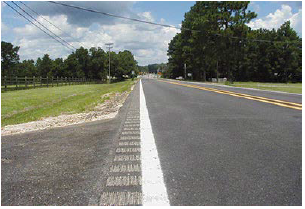
Where to Use: According to Massachusetts DOT guidance, edge lines shall be placed on paved rural arterials with a traveled way of 20 feet or more and an ADT of 6,000 vpd or greater.
| Install Edge Line Markings - Initial Investment: $16,000 - Cost of Maintenance: n/a - Frequency of Maintenance: 5 years (2 applications) |
Benefit-Cost Ratio | NCHRP 500 Performance Rating | Crash Modification Factor (CMF) |
|---|---|---|---|
| Lower Volume Optimal Conditions | 27.9 | Proven | 0.56-0.62 |
| Higher Volume Optimal Conditions | 222.8 | Proven | 0.56-0.62 |
| Lower Volume Narrower Conditions | 34.1 | Proven | 0.56-0.62 |
| Higher Volume Narrower Conditions | 336.1 | Proven | 0.56-0.62 |
Top Recommended Resources:
1. Massachusetts DOT, Pavement Markings: Centerlines and Edgelines, January 2008. Available at: http://www.mhd.state.ma.us/safetytoolbox/downloads/PavementMarkings_CL_EL.pdf.
2. FHWA, Roadway Departure Safety: A Manual for Local Rural Road Owners, January 2011. Available at: http://safety.fhwa.dot.gov/local_rural/training/fhwasa1109/fhwasa1109.pdf.
Center line markings separate two opposing traffic streams on a roadway, guide the road user, and delineate travel lanes. The MUTCD states that center line markings must be yellow. A single solid center line is used to discourage crossing, a double line prohibits crossing, and a broken center line is used to indicate a passing zone.
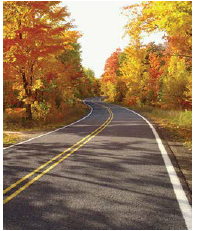
Where to Use: According to Massachusetts DOT guidance, center lines are required on all paved urban arterials and collectors that have a traveled way of 20 feet or more in width and an ADT volume of 6,000 vpd or greater.
| Install Center Line Markings - Initial Investment: $16,000 - Cost of Maintenance: n/a - Frequency of Maintenance: 5 years (2 applications) |
Benefit-Cost Ratio | NCHRP 500 Performance Rating | Crash Modification Factor (CMF) |
|---|---|---|---|
| Lower Volume Optimal Conditions | 35.1 | Proven | 0.67 |
| Higher Volume Optimal Conditions | 281.0 | Proven | 0.67 |
| Lower Volume Narrower Conditions | 43.0 | Proven | 0.67 |
| Higher Volume Narrower Conditions | 424.0 | Proven | 0.67 |
Top Recommended Resources:
1. Massachusetts DOT, Pavement Markings: Centerlines and Edgelines, January 2008. Available at:http://www.mhd.state.ma.us/safetytoolbox/downloads/PavementMarkings_CL_EL.pdf.
2. FHWA, Roadway Departure Safety: A Manual for Local Rural Road Owners, January 2011. Available at: http://safety.fhwa.dot.gov/local_rural/training/fhwasa1109/fhwasa1109.pdf.
Pavement markings provide continuous information to road users related to the roadway alignment, vehicle positioning, and other important driving-related tasks. Edge line width has been found to statistically lower nighttime fatal and injury crashes. A standard edge line marking is 4 inches, and wider edge line markings can range from 4 inches to 8 inches in width.

Where to Use: This treatment may be beneficial for locations that experience run-off-road and opposite-direction crashes that occur at night or on curves.
| Safety Treatment | Initial Implementation Cost | NCHRP 500 Performance Rating | Crash Modification Factor (CMF) |
|---|---|---|---|
| Install Wider Pavement Markings (With or Without Rumble Strips) | $5,001 to $20,000 | Experimental | 0.65-0.96 |
Top Recommended Resource:
1. Carlson, P., E. Park, and C. Anderson, "The Benefits of Pavement Markings: A Renewed Perspective Based on Recent and Ongoing Research," Paper No. 09-0488, August 2008.
Lane narrowing features the introduction of rumble strips on the outside shoulders and in a painted yellow median island on the major road approaches. The objective of lane narrowing is to induce drivers on major roads to reduce approach speeds at intersections by effectively reducing the lane width.
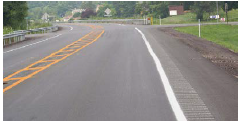
Where to Use: This practice has greater potential for effectiveness for intersections on high-speed roadways. However, the treatment can also be applied to intersections with lower posted speed limits.
| Safety Treatment | Initial Implementation Cost | NCHRP 500 Performance Rating | Crash Modification Factor (CMF) |
|---|---|---|---|
| Implement Lane Narrowing Through Rumble Strips and Painted Median at Rural Stop-Controlled Approaches | $5,001 to $50,000 | Tried | 0.60-0.80 |
Top Recommended Resource:
1. FHWA, Summary Report: Two Low-Cost Safety Concepts for Two-Way STOP-Controlled, Rural Intersections on High-Speed Two-Lane, Two-Way Roadways, December 2008. Available at: https://www.fhwa.dot.gov/publications/research/safety/08063/.
This treatment refers to installing both center line and edge line markings on a roadway.
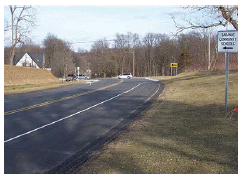
Where to Use: Any road with a history of run-off-road-right, head-on, opposite-direction-sideswipe, or run-off-road-left crashes is a candidate for this treatment. Depending on the width of the roadway, various combinations of edge line and/or center line pavement markings may be the most appropriate.
| Install Center Line and Edge Line Markings - Initial Investment: $32,000 - Cost of Maintenance: n/a - Frequency of Maintenance: 5 years (2 applications) |
Benefit-Cost Ratio | NCHRP 500 Performance Rating |
|---|---|---|
| Lower Volume Optimal Conditions | 16.5 | Proven |
| Higher Volume Optimal Conditions | 132.1 | Proven |
| Lower Volume Narrower Conditions | 20.2 | Proven |
| Higher Volume Narrower Conditions | 199.3 | Proven |
Top Recommended Resources:
1. FHWA, Roadway Departure Safety: A Manual for Local Rural Road Owners, January 2011. Available at: http://safety.fhwa.dot.gov/local_rural/training/fhwasa1109/fhwasa1109.pdf.
A road diet involves converting an undivided four-lane roadway into three lanes made up of two through lanes and a center Two-Way Left Turn Lane (TWLTL). The reduction of lanes allows the roadway to be reallocated for other uses such as bike lanes, pedestrian crossing islands, and/or parking. Road diets have multiple safety and operational benefits for vehicles as well as pedestrians, such as:

Where to Use: Road diets can be low cost if planned in conjunction with reconstruction or simple overlay projects, since a road diet mostly consists of restriping. Roadways with Average Daily Traffic (ADT) of 20,000 or less may be good candidates for a road diet and should be evaluated for feasibility. It has been shown that roads with 15,000 ADT or less had very good results in the areas of safety, operations, and livability. Driveway density, transit routes, the number and design of intersections along the corridor, as well as operational characteristics are some considerations to be evaluated before deciding to implement a road diet.
| Safety Treatment | Initial Implementation Cost | NCHRP 500 Performance Rating | Crash Modification Factor (CMF) |
|---|---|---|---|
| Implement Lane Narrowing Through Rumble Strips and Painted Median at Rural Stop-Controlled Approaches | $20,001 | Proven | 0.71-0.95 |
Top Recommended Resource:
1. FHWA, Proven Safety Countermeasures: Road Diet (Roadway Reconfiguration), December 2011. Available at: http://safety.fhwa.dot.gov/provencountermeasures/fhwa_sa_12_013.htm.
A Two-Way Left Turn Lane (TWLTL) is a lane placed between opposing lanes of traffic for the purpose of allowing traffic from either direction to make left turns off of a roadway.
TWLTLs remove left turning vehicles from the through lanes, which can reduce delay to through vehicles and can lead to a reduction in rear-end and sideswipe collisions. Second, TWLTLs provide spatial separation between opposing lanes of traffic, which can lead to a reduction in head-on collisions. The TWLTLs can also function as a lane for emergency vehicles.
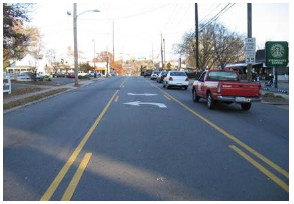
Where to Use: Current and future operational conditions such as capacity and level of service, safety conditions, traffic volumes (including trucks), and left turn volumes, along with type of land use, future development, and driveway and intersection densities should be considered before implementation.
Lower cost installations of TWLTLs can be a cost-effective treatment for two-lane rural locations, especially those with a high frequency of rear-end collisions involving a lead vehicle desiring to make a turn.
| Safety Treatment | Initial Implementation Cost | NCHRP 500 Performance Rating |
|---|---|---|
| Convert a Four-Lane Two-Way Road into a Five-Lane Road with Two Lanes in Each Direction of Travel Plus a Continuous Two-Way Left Turn Lane OR Convert a Two-Lane Two-Way Road into a Three-Lane Road Plus a Continuous Two-Way Left Turn Lane |
$20,001 to $100,000 | Tried |
Top Recommended Resources:
1. Iowa DOT. Design Manual, "Chapter 6," December 2010. Available at: http://www.iowadot.gov/design/dmanual/manual.html.
2. FHWA, Safety Evaluation of Installing Center Two-Way Left Turn Lanes on Two-Lane Roads, March 2007. Available at: https://www.fhwa.dot.gov/publications/research/safety/08042/08042.pdf.
32 As discussed in Section 1.2, a BCR is only shown where data were available to calculate the ratio. Where data were unavailable, the BCR has been left blank. [ Return to note 32. ]
33 As stated in NCHRP Series 500 Reports (http://safety.transportation.org/guides.aspx). Proven: The safety effect for other similar applications has shown a proven benefit. Tried: The treatment has indications that it can be expected to reduce crashes, but has some conflicting reports as to its associated safety effects or has been deployed and observed to be effective. Experimental: New treatments that still need to be tested and for which the safety effect is unknown. Unknown: Not enough is known about an associated safety performance. [ Return to note 33. ]
